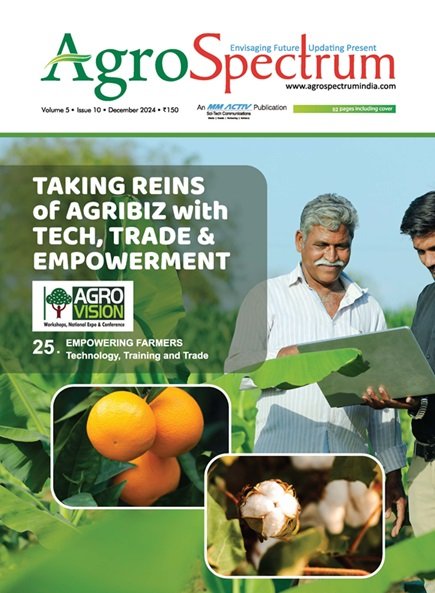Tuesday, 2 December 2025

The growing availability and affordability of internet connectivity in rural India has allowed for the widespread use of online platforms, data-driven solutions, and mobile applications in agriculture. Internet accessibility enables farmers to acquire critical information, track market prices, and receive real-time weather forecasts. As a result, farmers can make more informed decisions, increasing overall efficiency and productivity in agricultural techniques.
Agricultural technology has contributed to the growth of India’s agriculture industry in many ways, including increased productivity, reduced environmental impact, and improved food security. The Indian government actively promotes agricultural modernisation and income enhancement for farmers through initiatives offering schemes, subsidies, and financial support for adopting agritech solutions. These measures aim to encourage farmers to embrace innovative technologies, fostering a more sustainable and efficient agricultural sector.
The effects of adverse weather events on agriculture require resilient technologies. Agritech solutions that tackle problems like shrinking water supplies and shifting climate patterns are becoming increasingly significant. Adaptive technologies are required to provide security so that agricultural systems can endure and adjust to the changing climatic circumstances.
The growing availability and affordability of internet connectivity in rural India has allowed for the widespread use of online platforms, data-driven solutions, and mobile applications in agriculture. Internet accessibility enables farmers to acquire critical information, track market prices, and receive real-time weather forecasts. As a result, farmers can make more informed decisions, increasing overall efficiency and productivity in agricultural techniques.
As a result of digitisation, farmers are more connected than ever, encouraging them to favour innovative technologies like cloud and IoT while implementing new agricultural ecosystems. Agribusiness marketplaces, biotechnology, sensing & IoT, and agricultural robotics are all examples of agritech aspects. Sensing technologies, IoT gadgets, innovative farming systems, and agricultural biotechnology are all receiving significant investments. These technology expenditures are influenced by the growth of the agricultural technology sector and are a result of the emergence of agritech companies and the broad use of sensor-based technology.
The adoption of modern agritech solutions faces challenges in remote or traditional agricultural regions due to insufficient education and awareness programs. Limited understanding among farmers in these areas hampers the widespread uptake of technology, affecting the potential benefits it could offer to the agricultural sector.
The biotechnology and biochemical segment are expected to hold the largest share of the market in a few years. This is due to its importance in improving crop characteristics, disease resistance, and total production. As genetic engineering and biotech applications gain traction in tackling agricultural difficulties, this category is expected to witness significant growth.
According to reports, the sensors and connected devices segment is expected to be the fastest-growing segment in the market from 2024 to 2029. The growth is attributed to the rising demand for precision agriculture. The increased use of IoT devices and sensor technology provides real-time monitoring of crops, soil conditions, and machinery performance. This improves decision-making, resource management, and overall farm efficiency, contributing to the segment’s rapid expansion.
The production and maintenance segment is anticipated to be the fastest-growing segment in the market from 2024 to 2029. This growth is due to the increasing emphasis on optimising agricultural processes. This segment includes technologies for crop production, machinery maintenance, and farm management. As farmers seek to increase output and streamline operations, the adoption of sophisticated solutions for production efficiency and equipment maintenance is expected to increase significantly.
Multiple factors such as the size of the agriculture industry, its contribution to the country’s GDP, investment portfolio and the robustness of the digital ecosystem define the maturity of the agritech landscape of a country.
To read more click on: https://agrospectrumindia.com/e-magazine